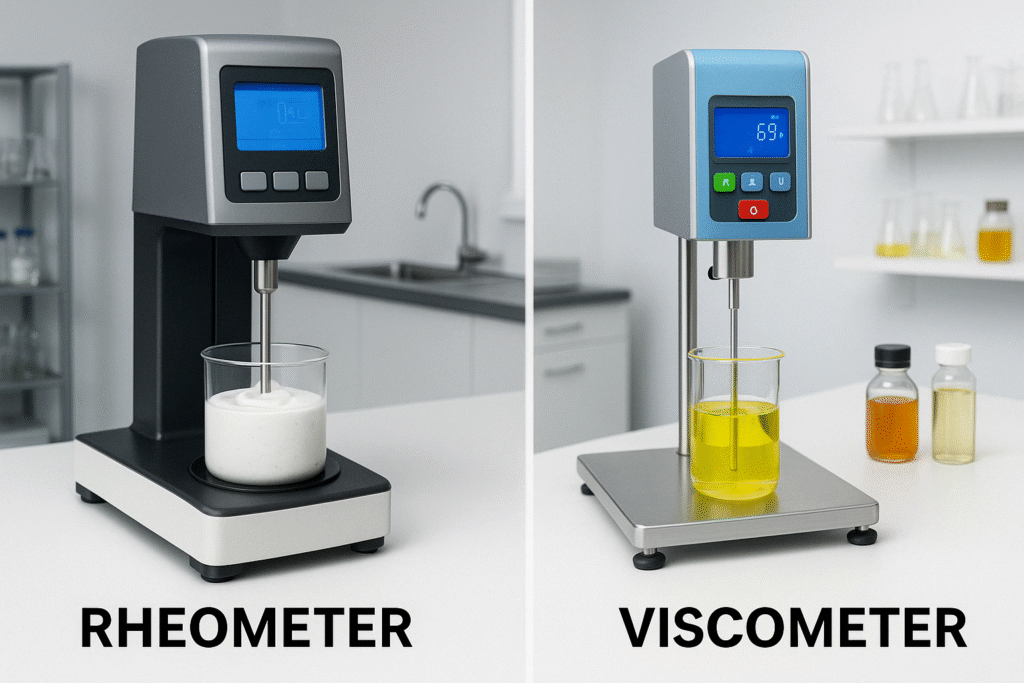Rheometer vs Viscometer: What’s the Real Difference and Why It Matters

If you’re working with fluids or semi-solids, choosing between a rheometer and a viscometer can be confusing. Both instruments measure flow properties—but what they tell you and how they operate are very different. Understanding these differences isn’t just helpful, it’s necessary for accurate material characterization.
This article breaks down the real distinction between rheometers and viscometers. Whether you’re in R&D, quality control, or manufacturing, you’ll walk away with the knowledge to make the right choice for your application.
What Is a Rheometer?
A rheometer is an advanced instrument used to analyze a material’s rheological behavior—that is, how it deforms and flows under different conditions. It measures viscosity, but it also goes far beyond that.
Rheometers allow you to:
- Adjust shear rate or shear stress
- Test time-dependent behavior like thixotropy or creep
- Measure yield stress and viscoelasticity
This means you can simulate real-world conditions, like squeezing toothpaste, spreading lotion, or pumping slurry through a pipe. A rheometer helps you understand how a material reacts under those changing forces.
There are different types of rheometers:
- Rotational rheometers, which apply controlled torque or speed to a sample.
- Capillary rheometers, which measure flow through a narrow tube under pressure.
Because they can handle a wide range of test modes, rheometers are widely used in research, formulation, and performance testing.
What Is a Viscometer?
A viscometer is a simpler instrument designed to measure one thing: viscosity under a fixed set of conditions. Viscosity is essentially a material’s resistance to flow—how thick or runny it is.
Viscometers provide a single value of viscosity, which is useful for comparing batches, checking product consistency, or meeting regulatory standards.
Common types of viscometers include:
- Capillary viscometers (like the Ubbelohde or Ostwald)
- Rotational viscometers
- Falling ball viscometers
They are easy to use, quick to set up, and relatively affordable. Many are portable, making them a good choice for on-site or production floor testing.
In industries where fluids behave consistently—such as oils, solvents, and syrups—a viscometer often provides all the data you need.
Core Differences Between Rheometers and Viscometers
Although both instruments deal with flow, the depth and type of analysis they provide are very different. Here’s a quick comparison:
| Feature | Rheometer | Viscometer |
| Purpose | Full rheological profile | Basic viscosity measurement |
| Shear Control | Adjustable shear rate/stress | Typically fixed |
| Material Behavior | Complex, non-Newtonian | Simple, Newtonian |
| Output | Multiple parameters | Single viscosity value |
| Test Modes | Static, dynamic, oscillatory | Limited modes |
| Cost | Higher investment | More affordable |
| Application | Research, product development | Routine QC, production checks |
So while a viscometer tells you how thick your fluid is, a rheometer tells you how it behaves under different stresses and over time.
Why Rheology Matters in Real-World Applications
You may wonder: why do I need to know more than just viscosity?
Consider these examples:
- Toothpaste: Needs to stay firm in the tube but flow easily when squeezed. That’s yield stress and thixotropy—measurable with a rheometer.
- Paint: Should spread evenly but not drip. This involves shear thinning behavior.
- Food sauces: Mouthfeel depends on viscoelasticity, not just thickness.
These behaviors don’t show up in a standard viscometer test. Using the wrong tool can result in incomplete or misleading data, which leads to product failure or performance issues.
That’s why rheometers are preferred when dealing with non-Newtonian fluids—materials whose viscosity changes depending on how they’re handled.
When Should You Use a Rheometer vs a Viscometer?
The choice depends on your testing goals and the type of material you’re dealing with.
Use a viscometer if:
- You need fast, repeatable measurements
- Your fluid has predictable, stable flow behavior
- You’re performing quality control on simple liquids like oils or syrups
Use a rheometer if:
- Your material exhibits complex or time-dependent behavior
- You’re developing a new formulation
- You need to simulate real-world conditions, like pumping, mixing, or squeezing
If you’re uncertain how a material will perform in the field, a rheometer can uncover behaviors that aren’t visible in viscosity readings alone.
Final Thoughts: Rheometer or Viscometer—Which Is Right for You?
Choosing between a rheometer and a viscometer isn’t just a technical decision—it’s a strategic one. Your choice impacts product development, performance, compliance, and customer satisfaction.
A viscometer gives you fast, easy answers when all you need is basic flow data. A rheometer gives you the full picture when your material is more complex or sensitive to stress, strain, or time.
Before making your choice, consider:
- How complex is your material?
- What kind of data do you actually need?
- Will your product face changing forces in real-world use?
Answering those questions will guide you to the right tool—and better outcomes down the line.
![HITV APP Download [Apk] Latest Version [Unlimited Movies]](https://hitvofficial.com/wp-content/uploads/2024/06/cropped-HiTV-Official-3.png)